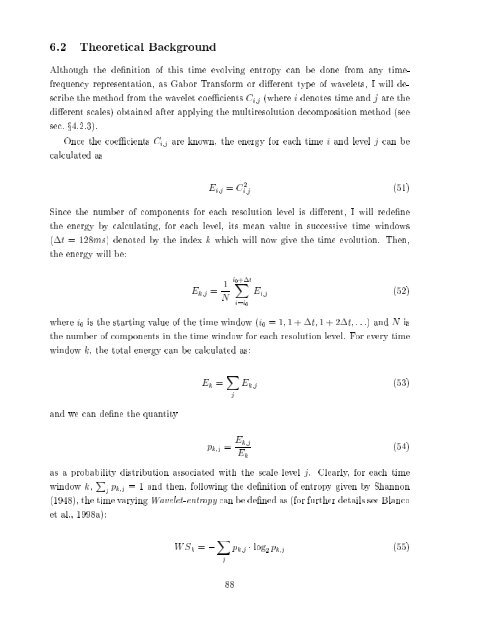Quantitative analysis of EEG signals: Time-frequency methods and ...
Quantitative analysis of EEG signals: Time-frequency methods and ...
Quantitative analysis of EEG signals: Time-frequency methods and ...
You also want an ePaper? Increase the reach of your titles
YUMPU automatically turns print PDFs into web optimized ePapers that Google loves.
6.2 Theoretical Background<br />
Although the denition <strong>of</strong> this time evolving entropy can be done from any time<strong>frequency</strong><br />
representation, as Gabor Transform or dierent type <strong>of</strong> wavelets, I will describe<br />
the method from the wavelet coecients C ij (where i denotes time <strong>and</strong> j are the<br />
dierent scales) obtained after applying the multiresolution decomposition method (see<br />
sec. x4.2.3).<br />
Once the coecients C ij are known, the energy for each time i <strong>and</strong> level j can be<br />
calculated as<br />
E ij = C 2 ij (51)<br />
Since the number <strong>of</strong> components for each resolution level is dierent, I will redene<br />
the energy by calculating, for each level, its mean value in successive time windows<br />
(t = 128ms) denoted by the index k which will now give the time evolution. Then,<br />
the energy will be:<br />
E kj = 1 N<br />
i 0<br />
X+t<br />
i=i 0<br />
E ij (52)<br />
where i 0 is the starting value <strong>of</strong> the time window (i 0 =1 1+t 1+2t : : :) <strong>and</strong> N is<br />
the number <strong>of</strong> components in the time window for each resolution level. For every time<br />
window k, the total energy can be calculated as:<br />
E k = X j<br />
E kj (53)<br />
<strong>and</strong> we can dene the quantity<br />
p kj = E kj<br />
E k<br />
(54)<br />
as a probability distribution associated with the scale level j. Clearly, for each time<br />
window k, P j p kj = 1 <strong>and</strong> then, following the denition <strong>of</strong> entropy given by Shannon<br />
(1948), the time varying Wavelet-entropy can be dened as (for further details see Blanco<br />
et al., 1998a):<br />
WS k = ; X j<br />
p kj log 2<br />
p kj (55)<br />
88




